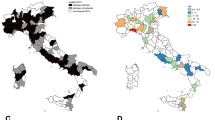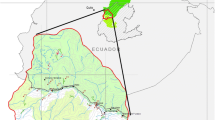Abstract
To detect Babesia-infected Ixodes persulcatus Shulze in a suburb of St. Petersburg, Russia, 738 adult ticks were studied using Babesia specific primers and PCR techniques. The entire sample (more than 1,200 individuals) was screened for the presence of Borrelia spp., Ehrlichia spp. and tick-borne encephalitis virus (TBEV). All 7 ticks infected with Babesia microti, were also infected with other pathogens (all 7 among 417 infected ticks, zero amongst the remaining 321 naive ones (χ2 = 5.25, p < 0.05). Babesia microti occurred twice with Borrelia afzelii, 3 times with Borrelia garinii, once with both, and once with both B. garinii and TBEV. The prevalence of infection with Borrelia spp. was 34.0%, with Ehrlichia spp. 6.2%, with TBEV 1.5%, and with Ba microti 0.9%. Babesia microti infection was not found in combination with Ehrlichia sp. or Borrelia burgdorferi sensu stricto. The latter pathogen (prevalence 2.6%), just like Ba. microti, was not encountered as a monoinfection. The data suggest that Ba. microti infection can only survive in I. persulcatus in combination with Borrelia spp. (7 of 7 infections). The disease in humans is more severe and longer-lasting when more than one pathogen is involved. Our observations show that the well known St. Petersburg focus of tick-borne encephalitis and Lyme disease is also a focus of ehrlichiosis and babesiosis.
Similar content being viewed by others
References
Alekseev A.N. 2000. The basic concepts of antagonistic and synergistic interactions in multi-component host-parasite systems. Acarina. 2: 133–135.
Alekseev A.N., Dubinina H.V. and Schouls L.M. 1998. First determination of Ehrlichia infected ticks among the primary vectors of the tick-borne encephalitis and borreliosis in the Russian Baltic Region. Bull. Scand. Soc. Parasitol. 8: 88–91.
Alekseev A.N., Dubinina H.V. and Semenov A.V. 2001. Mixtinfections in ticks of the genus Ixodes (Acarina: Ixodidae). In: Uskov A. (ed.), Tick-Borne and Parasitic Diseases. Mater Workshop AllRus. Sci. Conf. “Clinic Perspectives in the Infectology” (17–18 October 2001, St. Petersburg). St.Petersburg: NPF Helix. pp. 9–16, [In Russian].
Alekseev A.N., Dubinina H.V., Van de Pol I. and Schouls L.M. 2001. Identification of Ehrlichia spp. and Borrelia burgdorferi in Ixodes ticks in the Baltic region of Russia. J. Clin. Microbiol. 39: 2237–2242.
Armstrong P.M., Katavolos P., Caporale D.A., Smith P.R., Spielman A. and Telford III S.R. 1998. Diversity of Babesia infecting deer ticks (Ixodes dammini). Am. J. Trop. Med. Hyg. 58: 739–742.
Barbour A.G. and Restrepo B.I. 2000. Antigenic variation in vector-borne pathogens. Emerg. Infect. Dis. 6: 449–457.
Bakken J.S. and Dumler J.S. 2001. Proper nomenclature for the HGE agent. Emerg. Infect. Dis. 7: 486.
Belikov S.I., Butina T.V., Demina T.V. and Zlobin V.I. 2002. Tick-borne encephalitis virus genotyping. Bull. East Siberian Sci. Centre. [In Russian] 2: 36–39.
Benach J.L., Coleman J.L. and Habicht G.S. 1981. Serologic evidence for simultaneous occurrences of Lyme disease and babesiosis. J. Infect. Dis. 144: 473–477.
Burgdorfer W., Barbour A.G., Hayes S.F., Benach J.L., Grunwaldt E. and Davis J.P. 1982. Lyme disease: a tick borne spirochetosis? Science 216: 1317–1319.
Chiz A.N., Konovalov A.I. and Kuntyshev I.I. 1951. Cattle babesiosis clinic in Ixodes persulcatus area. Proc. Leningrad Veterinary Inst. [In Russian] 4: 127–132.
Chu F.K. 1998. Rapid and sensitive PCR-based detection and identification of aetiologic agents of human granulocytotropic and monocytotropic ehrlichiosis. Mol. Cell. Probe. 12: 93–99.
Duh D., Petrovec M. and Avsic-Zupanc T. 2001. Diversity of Babesia infecting European sheep ticks (Ixodes ricinus). J. Clin. Microbiol. 39: 3395–3397.
Filippova N.A. 1990. Taxonomic aspects of the Lyme disease agent transmission. Parasitology 24: 257–267, [In Russian].
Homer M.J., Aguilar Delfin I., Telford III S.R., Krause P.J. and Persing D.H. 2000. Babesiosis. Clin. Microbiol. Rev. 13: 451–469.
Johnson R.C., Schmid G.P., Hyde F.W., Steigerwalt A.G. and Brenner D.J. 1984. Borrelia burgdorferi sp. nov.: etiologic agent of Lyme disease. Int. J. Bacteriol. 34: 496–497.
Kjemtrup A.M. and Conrad P.A. 2000. Human babesiosis: an emerging tick-borne disease. Int. J. Parasitol. 30: 1323–1337.
Korenberg E.I., Shcherbakov S.V., Kovalevskii Yu. V., Kriuchechnikov V.N. and Nikitina O.V. 1988. Borrelia burgdorferi transmission from nymphs to imago in tick Ixodes persulcatus Schulze. Dokl. Akad. Nauk SSSR. 302: 759–760.
Krause P.J., Telford III S.R., Spielman A., Sikand V., Ryan R., Christianson D. et al. 1996. Concurrent Lyme disease and babesiosis: Evidence for increased severity and duration of illness. JAMA 275: 1657–1660.
Marconi R.T. and Garon C.F. 1992. Development of PCR primer sets for diagnosis of Lyme disease and for species-specific identification of Lyme disease isolates by 16S rRNA signature nucleotide analysis. J. Clin. Microbiol. 30: 2830–2834.
Persing D.H., Mathiesen D., Marshall W.F., Telford III S.R., Spielman A., Thomford J.W. et al. 1992. Detection of Babesia microti by polymerase chain reaction. J. Clin. Microbiol. 30: 2097–2103.
Piesman J. 1989. Transmission of Lyme disease spirochetes (Borrelia burgdorferi). Exp. Appl. Acarol. 7: 71–80.
Piesman J., Hicks T.C., Sinsky R.J. and Obiri G. 1987. Simultaneous transmission of Borrelia burgdorferi and Babesia microti by individual nymphal Ixodes dammini ticks. J. Clin. Microbiol. 25: 2012–2013.
Rabinovich S.A., Voronina Z.K., Stepanova N.I., Maruashvili G.M., Bakradze T.L., Odishariya M.S. et al. 1978. First detection of human babesiasis in the USSR and brief analysis of the recorded cases in literature. Med. Parazitol. (Moscow) [In Russian] 3: 97–107.
Ravyn M.D., Korenberg E.I., Oeding J.A., Kovalevskii Y.V. and Johnson R.C. 1999. Monocytic Ehrlichia in Ixodes persulcatus ticks from Perm, Russia. Lancet 353: 722–723.
Semenov A.V., Alekseev A.N. and Dubinina H.V. 2000. Electorophoretypes, genotypes and Borrelia agents of Ixodes persulcatus ticks. Bull. Scand. Soc. Parasitol. 10: 88–89.
Spielman A., Wilson M.L., Levine J.F. and Piesman J. 1985. Ecology of Ixodes dammini-borne human babesiosis and Lyme disease. Annu. Rev. Entomol. 30: 439–460.
Terletsky A.B. and Akhmerova L.G. 2002. Human babesiosis: clinic, diagnostic and treatment. In: Shaykin V.I. (ed.), Parasitology-Priorities and Perspectives of Development. Mater Interreg. Conf. dedicated to the memory of late professor Volkov F.A. (8 February 2002, Novosibirsk). Novosibirsk: Inst. Exp. Vet. Siberia and Far East SO RASKHN. pp. 101–106, [In Russian].
Vorobyeva N.N., Korenberg E.I. and Grigoryan E.V. 2001. Clinico-laboratorian diagnostique of tickborne infections in the endemic region. In: Uskov A. (ed.), Tick-Borne and Parasitic Diseases. Mater Workshop AllRus. Sci. Conf. “Clinic Perspectives in the Infectology” (17–18 October 2001, St. Petersburg). St.Petersburg: NPF Helix. pp. 17–19, [In Russian].
Zilber L.A. 1939. Spring (spring-summer) endemic tick-borne encephalitis. Archiv. Biol. Sci. 56: 9–37, [In Russian].
Author information
Authors and Affiliations
Corresponding author
Rights and permissions
About this article
Cite this article
Alekseev, A.N., Semenov, A.V. & Dubinina, H.V. Evidence of Babesia microti infection in multi-infected Ixodes persulcatus ticks in Russia. Exp Appl Acarol 29, 345–353 (2003). https://doi.org/10.1023/A:1025841901909
Issue Date:
DOI: https://doi.org/10.1023/A:1025841901909




